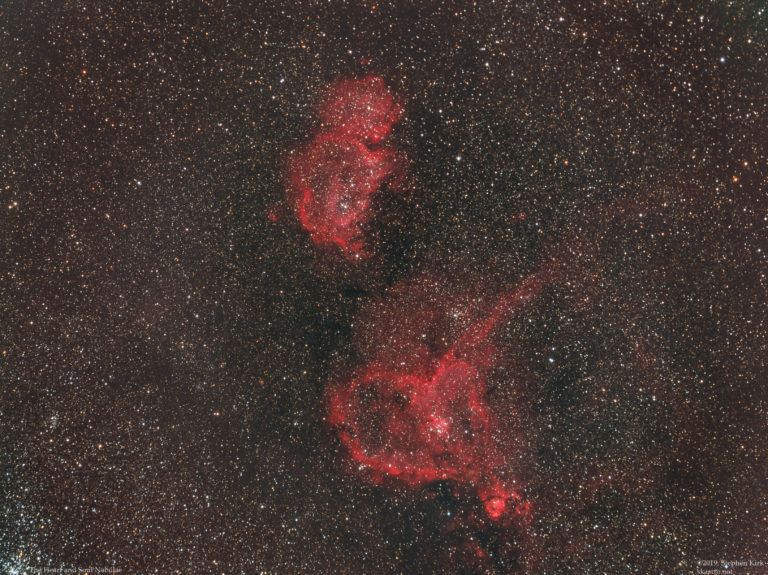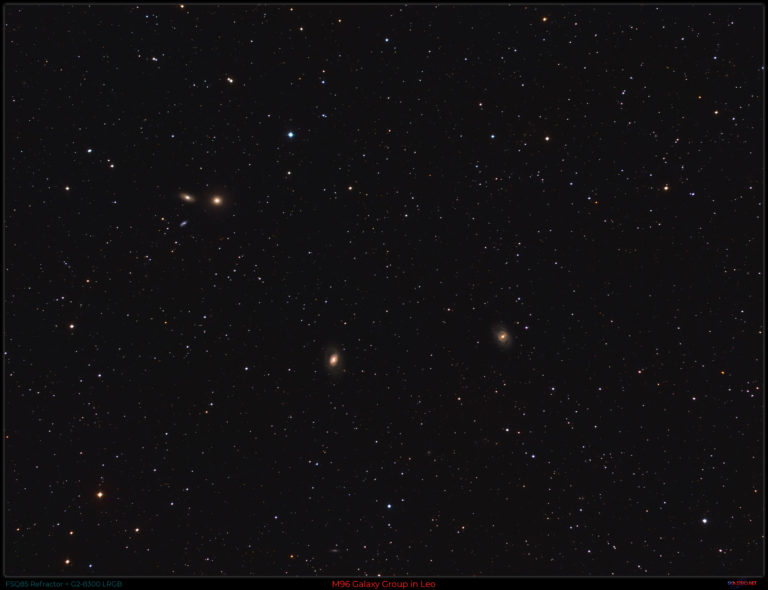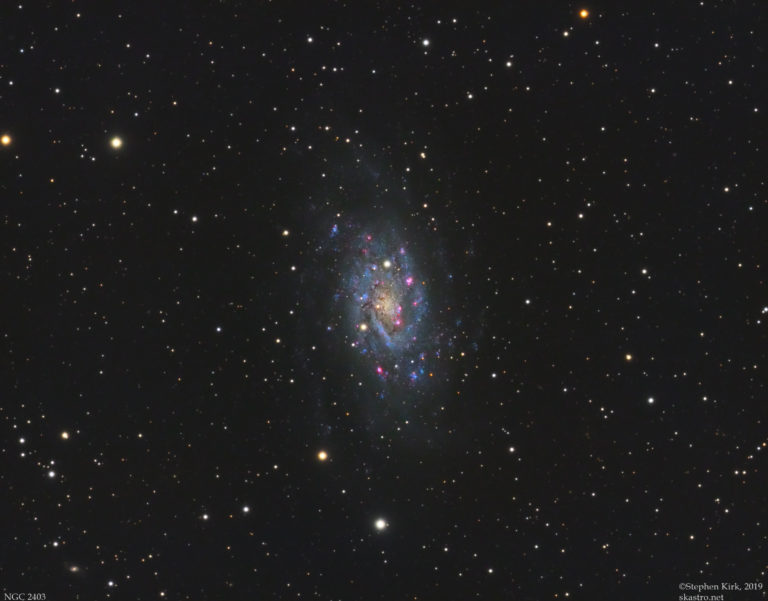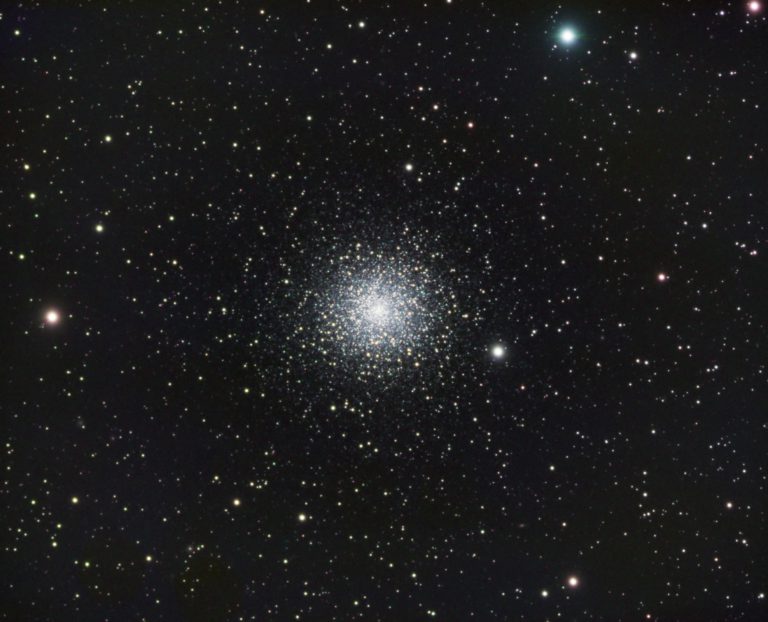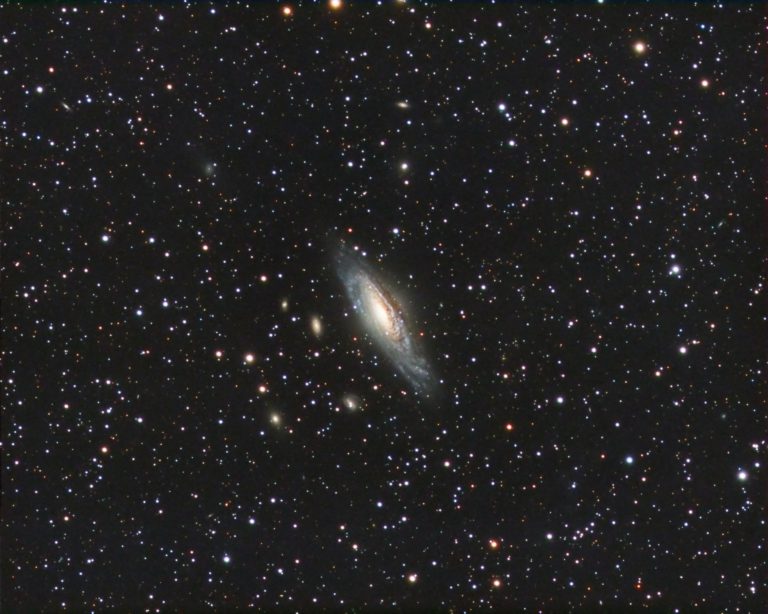The Heart and Soul Nebulae are a well known and famous pairing of Nebulae in the late summer/autumn sky of the Northern Hemisphere. These nebulae are located far away – 7500 light years – in the Perseus arm of the galaxy, further out from the core of the galaxy than the Sun and are vast star forming regions rich in Hydrogen Alpha that gives the images the intense red glow.All image data collected with a Samyang 135mm lens at F2.8 with a Moravian G2-8300 CCD camera. Below is the RGB image gathered with Astrodon RGB filters. All binned 1×1: Red 14 x 300s; Green 13 x 300s; Blue 14 x 300s. This gives an RGB integration time of 210 minutes or three and a half hours.The picture looks nice but it does lack punch and vibrancy as it stands. It needs the addition of the Hydrogen Alpha data that will…
The M96 Group is a cluster of galaxies in the constellation of Leo. Not to be confused with the separate and arguably more famous Leo triplet. The M96 group contains three Messier galaxies (M95, M96 and M105) and many fainter galaxies in the background. The three main galaxies are about 35 million light years away and are easily visible in small telescopes. M96 Group Image Technical Data Technical Information Imaged from my backyard, March 2019, in Nottingham, UK. I used my FSQ85 refractor with 0.73 reducer and my Moravian instruments G2-8300 CCD camera and Astrodon LRGB filters. Mount is my MESU200 and guided with an Off-Axis guider. Image acquisition data:Luminance 11 x 600s 1×1; Red 9 x 300s 2×2; Green 10 x 300s 2×2; Blue 10 x 300s 2×2 M96 Group Annotated
NGC 2403 is a spiral galaxy located about eight million light years away in the constellation of Camelopardalis in the Northern hemisphere. It is an outlying member of the M81/M82 group. You will note that it bares a striking resemblance to M33 and contains huge HII star forming regions. NGC2403 is much smaller than our own galaxy, being only about 50000 light years in diameter as opposed to about 120000 light years for our own Milky Way galaxy. It is not known why a smaller galaxy like this should have such huge HII regions that dwarf those of our own, larger galaxy. NGC 2403 Image Technical Data Imaged from my backyard, March 2019, in Nottingham, UK. I used my TEC 140 refractor with Atik 460 CCD camera and Astrodon LRGB filters. Image acquisition data, everything binned 1×1 Luminance 29 x 600s; Red 12 x 300s; Green 12 x 300s; Blue 12…
M15 is a magnificent Globular Cluster in the constellation of Pegasus, which after M13 and M92 is arguably the best one visible to Northern Hemisphere observers. It is located about 34000 light years away and is about 125 light years in diameter with an age of 12 billion years, it is as old as the Milky Way itself. M15 Globular Cluster Image Technical Data Imaged with my TEC 140 refractor and Atik 460 CCD camera September 24th 2018. Mount is my MESU 200 guided with off-axis guiding. Red 22 x 300s 1×1; Green 12 x 300s 1×1; Blue 19 x 300s 1×1 Total Integration of the data set is about four and a half hours. Note that I did not use a separate luminance channel and instead I binned each of the RGB channels 1×1. I remain to be convinced of the need to capture a separate luminance channel with either globular or open…
NGC 7331 (Caldwell 30) is a spiral galaxy about 46 million light years away in the constellation of Pegasus. It is a vibrant and colorful galaxy, often referred to as the Milky Way’s “twin” due to it being of a similar size and mass to our own galaxy. It is visible in amateur telescopes as a faint smudge if the sky is dark. In the images below, the smaller galaxies to the left of the main galaxy are a chance line-of-sight alignment. These four galaxies are much more distant than NGC 7331 (about 320 million light years) and are nothing to do with the main galaxy. This collection of galaxies (NGC 7331 and the distant background galaxies are collectively referred to as the Deer Lick Group named after the Deer Lick gap in the mountains of North Carolina by astronomer Tomm Lorenzin who liked to observe from there. NGC 7331…

